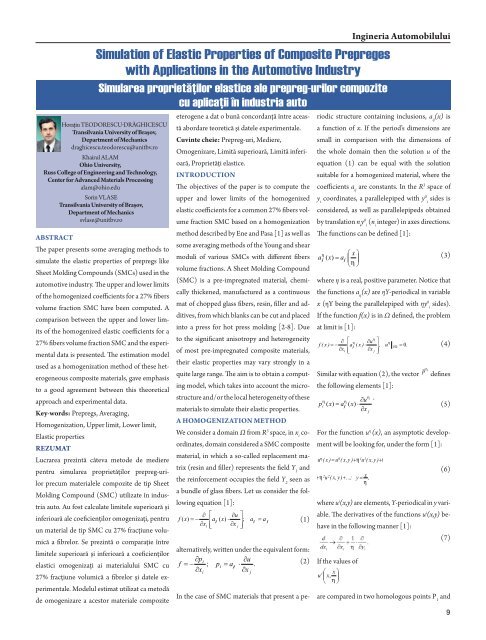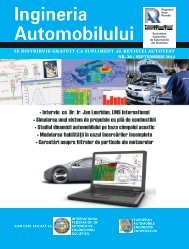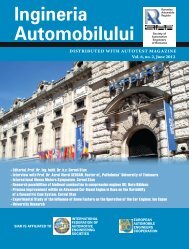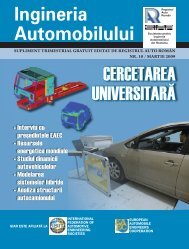DACIA ELECTRA - ingineria-automobilului.ro
DACIA ELECTRA - ingineria-automobilului.ro
DACIA ELECTRA - ingineria-automobilului.ro
Create successful ePaper yourself
Turn your PDF publications into a flip-book with our unique Google optimized e-Paper software.
Simulation of Elastic P<strong>ro</strong>perties of Composite Prepreges<br />
with Applications in the Automotive Industry<br />
Simularea p<strong>ro</strong>prietăţilor elastice ale prepreg-urilor compozite<br />
cu aplicaţii în industria auto<br />
Ingineria Automobilului<br />
ete<strong>ro</strong>gene a dat o bună concordanţă între această<br />
abordare teoretică și datele experimentale.<br />
Cuvinte cheie: Prepreg-uri, Mediere,<br />
Omogenizare, Limită superioară, Limită inferioară,<br />
P<strong>ro</strong>prietăţi elastice.<br />
INTRODUCTION<br />
Th e objectives of the paper is to compute the<br />
upper and lower limits of the homogenized<br />
elastic coeffi cients for a common 27% fi bers volume<br />
fraction SMC based on a homogenization<br />
method described by Ene and Pasa [1] as well as<br />
ABSTRA CT<br />
some averaging methods of the Young and shear<br />
Th e paper presents some averaging methods to<br />
moduli of various SMCs with diff erent fi bers<br />
simulate the elastic p<strong>ro</strong>perties of prepregs like<br />
volume fractions. A Sheet Molding Compound<br />
Sheet Molding Compounds (SMCs) used in the<br />
(SMC) is a pre-impregnated material, chemi-<br />
automotive industry. Th e upper and lower limits<br />
cally thickened, manufactured as a continuous<br />
of the homogenized coeffi cients for a 27% fi bers<br />
mat of chopped glass fi bers, resin, fi ller and ad-<br />
volume fraction SMC have been computed. A<br />
ditives, f<strong>ro</strong>m which blanks can be cut and placed<br />
comparison between the upper and lower lim-<br />
into a press for hot press molding [2-8]. Due<br />
its of the homogenized elastic coeffi cients for a<br />
to the signifi cant anisot<strong>ro</strong>py and hete<strong>ro</strong>geneity<br />
27% fi bers volume fraction SMC and the experi-<br />
of most pre-impregnated composite materials,<br />
mental data is presented. Th e estimation model<br />
their elastic p<strong>ro</strong>perties may vary st<strong>ro</strong>ngly in a<br />
used as a homogenization method of these het-<br />
quite large range. Th e aim is to obtain a compute<strong>ro</strong>geneous<br />
composite materials, gave emphasis<br />
ing model, which takes into account the mic<strong>ro</strong>-<br />
to a good agreement between this theoretical<br />
structure and/or the local hete<strong>ro</strong>geneity of these<br />
app<strong>ro</strong>ach and experimental data.<br />
materials to simulate their elastic p<strong>ro</strong>perties.<br />
Key-words: Prepregs, Averaging,<br />
A HOMOGENIZATION METHOD<br />
Homogenization, Upper limit, Lower limit,<br />
We consider a domain Ω f<strong>ro</strong>m R<br />
Elastic p<strong>ro</strong>perties<br />
REZUMAT<br />
Lucrarea prezintă câteva metode de mediere<br />
pentru simularea p<strong>ro</strong>prietăţilor prepreg-urilor<br />
precum materialele compozite de tip Sheet<br />
Molding Compound (SMC) utilizate în industria<br />
auto. Au fost calculate limitele superioară și<br />
inferioară ale coefi cienţilor omogenizaţi, pentru<br />
un material de tip SMC cu 27% fracţiune volumică<br />
a fi brelor. Se prezintă o comparaţie între<br />
limitele superioară și inferioară a coefi cienţilor<br />
elastici omogenizaţi ai materialului SMC cu<br />
27% fracţiune volumică a fi brelor și datele experimentale.<br />
Modelul estimat utilizat ca metodă<br />
de omogenizare a acestor materiale compozite<br />
3 riodic structure containing inclusions, a (x) is<br />
ij<br />
a function of x. If the period’s dimensions are<br />
small in comparison with the dimensions of<br />
the whole domain then the solution u of the<br />
equation (1) can be equal with the solution<br />
suitable for a homogenized material, where the<br />
coeffi cients a are constants. In the R ij<br />
space, in x co- i<br />
ordinates, domain considered a SMC composite<br />
material, in which a so-called replacement matrix<br />
(resin and fi ller) represents the fi eld Y and 1<br />
the reinforcement occupies the fi eld Y seen as<br />
2<br />
a bundle of glass fi bers. Let us consider the following<br />
equation [1]:<br />
∂ ⎡ ∂u<br />
⎤<br />
f ( x)<br />
= − ⎢aij<br />
( x)<br />
⋅ ⎥;<br />
aij<br />
= a ji<br />
(1)<br />
∂xi<br />
⎢⎣<br />
∂x<br />
j ⎥⎦<br />
alternatively, writt en under the equivalent form:<br />
∂pi<br />
∂u<br />
f = − ; pi<br />
= aij<br />
⋅ .<br />
(2)<br />
∂xi<br />
∂x<br />
j<br />
In the case of SMC materials that present a pe-<br />
3 space of<br />
y coordinates, a parallelepiped with y i 0 sides is<br />
i<br />
considered, as well as parallelepipeds obtained<br />
by translation n y i 0<br />
i (n integer) in axes directions.<br />
i<br />
Th e functions can be defi ned [1]:<br />
η ⎛ x ⎞<br />
aij ( x)<br />
= aij<br />
⎜ ⎟<br />
(3)<br />
⎝η<br />
⎠<br />
where η is a real, positive parameter. Notice that<br />
the functions a (x) are ηY-periodical in variable<br />
ij<br />
x (ηY being the parallelepiped with ηy0 i sides).<br />
If the function f(x) is in Ω defi ned, the p<strong>ro</strong>blem<br />
at limit is [1]:<br />
⎡<br />
η<br />
∂ u ⎤<br />
η ∂<br />
η<br />
f ( x ) = − ⎢aij<br />
( x ) ⋅ ⎥,<br />
u = 0.<br />
(4)<br />
∂Ω<br />
∂xi<br />
⎢⎣<br />
∂x<br />
j ⎥⎦<br />
η<br />
p<br />
Similar with equation (2), the vector<br />
r<br />
defi nes<br />
the following elements [1]:<br />
η<br />
∂u<br />
.<br />
η η<br />
pi<br />
( x)<br />
= aij<br />
( x)<br />
⋅<br />
(5)<br />
∂x<br />
j<br />
For the function uη (x), an asymptotic development<br />
will be looking for, under the form [1]:<br />
uη<br />
( x ) = u0(<br />
x,<br />
y ) + η 1u1(<br />
x,<br />
y ) + η<br />
(6)<br />
u ( x,<br />
y ) ...; y x ,<br />
2 2 + η + =<br />
η<br />
where ui (x,y) are elements, Y-periodical in y variable.<br />
Th e derivatives of the functions ui (x,y) behave<br />
in the following manner [1]:<br />
(7)<br />
If the values of<br />
⎛ x ⎞<br />
u ⎜ x ⎟<br />
⎝ η ⎠<br />
i<br />
Horaţiu TEODORESCU-DRĂGHICESCU<br />
Transilvania University of Braşov,<br />
Department of Mechanics<br />
draghicescu.teodorescu@unitbv.<strong>ro</strong><br />
Khairul ALAM<br />
Ohio University,<br />
Russ College of Engineering and Technology,<br />
Center for Advanced Materials P<strong>ro</strong>cessing<br />
alam@ohio.edu<br />
Sorin VLASE<br />
Transilvania University of Braşov,<br />
Department of Mechanics<br />
svlase@unitbv.<strong>ro</strong><br />
,<br />
are compared in two homologous points P and 1<br />
9















